This post may contain affiliate ads at no cost to you. See my disclosures for more information.
Trees are a beautiful gift to our planet. They provide beauty. They offer shade. They hold the soil to the earth. They provide shelter and food for many animals. They convert the carbon dioxide we breathe out into oxygen that we breathe in. Where would we be without trees?
In this post I’ve compiled a list of more than 20 children’s books about trees, complete with a description of each book and suggested age range. The books below include both fiction and non-fiction selections about trees.
Share these books with the children in your life to encourage a love and appreciate of nature, especially our magnificent trees!
Note: For more botany activities, see my Botany Unit Study page.

Starting with Nature Tree Book by Pamela Hickman
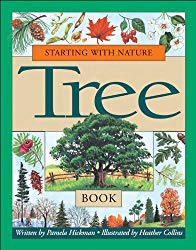
This is a beautiful book with rich illustrations and great information about trees for children ages 8-12. The book discusses how different types of trees grow in different habitats, and explains how trees provide homes for many animals. The book also includes several suggested activities for learning about trees. If you have access to pine cones, there is a great pine cone experiment to learn how different pine cones spread their seeds.
Be a Friend to Trees by Patricia Lauber

This book uses relatively simply language to explain all the wonderful qualities about trees – how they provide shelter for animals, provide wood for things humans need, provide sap for syrup and rubber, provide food for humans and animals to eat, and provide oxygen for us to breathe. The book provides a basic description of photosynthesis so children can learn how trees make their own food. The overall message is that tree do so many important things, and therefore we should all be a friend to trees. Ages 4 to 8.
I Can Name 50 Trees Today!: All About Trees by Bonnie Worth
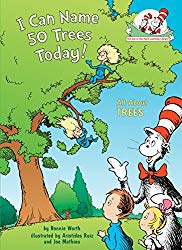
This book is part of the Cat in the Hat Learning Library series. As such, even though it was not written by Dr. Seuss himself, it features many famous Dr. Seuss characters and is written in typical Dr. Seuss rhyme. This book features the famous Cat in the Hat inviting two children to learn about trees. The book introduces parts of a tree (e.g. roots, branches, crown, leaves, bark); some very basic information about the process by which trees make food from water, carbon dioxide, and sunshine; and detailed information about the different shapes that leaves may take. One page shares how we can count the rings on a tree in order to determine its age. Throughout the pages, young readers are introduced to 50 different kinds of trees. Ages 4 to 8.
Red Leaf, Yellow Leaf by Lois Ehlert
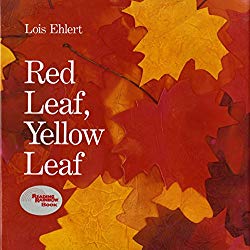
The title of this book is misleading, as this book is more about one person’s special tree than about leaves per sé. The book traces the path one tree took from seed to sprout to tree. The particular tree at the center of this story is a sugar maple eventually purchased by a family for their yard. The child who narrates the story observes signs each spring that her tree is growing, enjoys the bushy green crown of her tree each summer, and delights in the red and yellow leaves that adorn her tree in fall.
The back of the book includes additional information about the parts of a tree and detailed instructions for planting a tree. My only quibble with this book was with a few of the illustrations. A few pages were, I felt, illustrated in such a way that young readers would have difficulty identify what the illustration was depicting. Ages 4 to 7.
A Tree Is Nice by Janice May Udry

This simple book extolls the virtues of trees. It celebrates the fact that trees make everything beautiful, that trees provide piles of leaves in the fall, and trees provide trunks for us to climb and branches for us to sit on. Ages 3-7.
The Great Kapok Tree: A Tale of the Amazon Rain Forest by Lynne Cherry

The Kapok tree grows in the Amazon rainforest, and this book was written to let the world know what happens to the creatures of the rain forest when their habitat is destroyed. In the story, a man goes into the Amazon and begins to chop down a Kapok tree. But he gets tired and decides to take a nap. While he naps, many creatures of the rain forest come to him and explain how the tree shelters them, provides them with food, and holds the soil in place to protect other plants. Ages 4-8.
The Busy Tree by Jennifer Ward
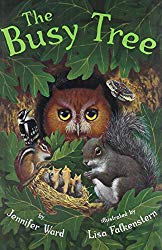
Trees may look still, but upon closer inspection they are teeming with activity and life! From roots burrowing deeper into the ground to owls sleeping in a tree’s hollow to children swinging from the branches, there is a lot of life and activity in a tree. This book uses spare, rhyming text paired with beautiful illustrations to highlight all of the activity going on with trees. Ages 3-7.
Our Tree Named Steve by Alan Zweibel

Once upon a time a family found a spot to build their home, and they needed to clear some trees out of the way. But the kids all fell in love with one tree on the property. The youngest child couldn’t say “tree” and so she called the tree “Steve.” So the house was built and Steve was saved. Over the years Steve helped the family to swing from the branches, play jump rope, and even dry the laundry. But after many years of enjoying Steve, a big storm sweeps through and knocks the old tree down. However, Steve will always be with the family in their hearts and thoughts. Ages 4 to 8.
Tree: A Peek-Through Picture Book by Britta Teckentrup

This adorable book will delight young children, as each page of this peek through book has additional cutouts that reveal new animals in the tree, from owls to bears to squirrels and more. Simple rhyming text accompanies the illustrations. This book is perfect for children ages 2 to 6.
Tell Me, Tree: All About Trees for Kids by Gail Gibbons

I am a huge fan of any book written by Gail Gibbons. She always does a great job presenting basic scientific and cultural facts about the topics of her books, including this one about trees. This book covers how trees grow, what bark is, how different trees have different kinds of seeds, how roots grow, how photosynthesis works, and so much more. But all this information is presented in a way that is accessible for young kids. Ages 5 to 8.
A Tree Is a Plant by Clyde Robert Bulla

This book focuses on the life cycle of an apple tree, starting with a seed, then a stem with leaves, and finally a tree. The book discusses how an apple tree changes over the course of the year, with blossoms in the spring and apples in the fall. The book explains how trees have roots that keep the tree from falling and take water from the ground for the tree to drink. Ages 4 to 8.
The Little Tree by Muon Van

In the shadows of an old forest stood a little tree. After a few years, the little tree had a little seed. The little tree asked a passing bird what trees were like in other areas. After learning about the diversity of trees the bird had seen, the little tree asked the bird to flap its wings in order to send the little seed far away. After many more years, the little tree wondered what had happened to her little seed, and a passing bird agreed to ask around. The little seed – which by now had grown into a large tree – responded by sending a leaf to assure its mother that it was alive and well. The author’s note at the back of the book explains how the little tree and little seed are a metaphor for the author’s mother, who escaped from Vietnam to live as a refugee, and eventually find a home in the United States. Ages 4 to 8.
The Tree in the Ancient Forest by Carol Reed-Jones

An ancient forest is a natural forest that has been allowed to grow without disturbance for at least 200 years. Trees in an ancient forest can be more than 1000 years old! This book, with rich, vivid illustrations that are totally captivating, uses repetitive text that builds from one page to the next to share a bit about the interconnected lives of the animals and plants that live in the ancient forest. Ages 5 to 8.
The Old Tree by Ruth Brown

In this sweet tale, all the animal inhabitants of a particular tree wake up to find a large ‘X’ painted on their tree, but no one knows what it means. However, when Captain Crow sees it, he understands what it means and he begins to panic – someone has marked their tree to be cut down! All the animals go into a tizzy, wondering how they can save their tree. Finally, the woodpeckers come up with a solution by building a little house right over the ‘X’ so that when the loggers come back, they don’t see the ‘X’ anymore. Instead, they see a little bird family resting in their home, and they let the tree be. The last page of the book has a surprise that will delight children as there is a pop-up tree with door to open and things to move and play with. Ages 4 to 8.
Big Tree Down! by Laurie Lawlor

Big Tree was a community landmark, but one day it was hit by lightning and it fell to the ground, taking some power lines with it. Emergency! The community came together to handle the situation. Police officers made sure the live wire wouldn’t cause a fire. The power company came to repair the line. The forest department came to chop up the tree and haul it away. Lots of people pitched in to keep everybody safe and get the power back on. And the community planted a new sapling where Big Tree had been before. Ages 3 to 7.
Planting the Trees of Kenya: The Story of Wangari Maathai by Claire A. Nivola

Wangari Maathai grew up on a farm in Kenya, where the earth was covered in many different kinds of trees. As an adult, she moved to the US for college before returning to her native Kenya after five years. However, the landscape she returned to had changed so much during those five years! Gone were the many trees that used to cover the hillside, and the people no longer grew their own food but purchased food from the store. But the food they bought was not as good as the food they had grown, and the people were sickly and weak. Wangari saw that the people had forgotten how to take care of the land that fed them. So she hatched a plan to plant trees, and she taught the women of her village to collect tree seeds, prepare the soil, and tend for the growing seedlings. Then she taught others, including men, schoolchildren, and soldiers. Over time, millions of new trees were planted in Kenya. Ages 5 to 9.
Seeds of Change: Wangari’s Gift to the World by Jen Cullerton Johnson

This is another book about Wangari Maathai, but compared to the book by Nivola reviewed above, this book focuses more on the early life of Wangari, including her culture-based relationship with trees and the earth. For example, when Wangari leaves her village at age 11 to study in Nairobi, her mom places a handful of dirt in her hands and tells her, “Where you go, we go.” This book goes into great details about Wangari’s studies in both Kenya and the US, including how she had to overcome poverty and cultural traditions that said women should not study and could not do the things that men do. It also dives into more detail about how the Kenyan government sold land to foreign companies that cut down forests for timber and cleared land for coffee. Of course, we also learn about her heroic efforts to plant millions of trees across Kenya. This inspiring book is best for kids ages 6 to 11.
Gus is a Tree by Claire Babin
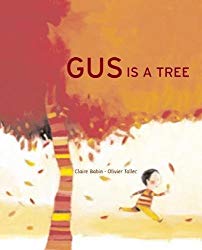
Gus is a young boy who loves trees. He loves their bark. He loves their leaves. In fact, he loves trees so much the he dreams he is a tree, experiencing all the joys of being in nature. The story contains tree-related vocabulary in all capital letters with a glossary at the back that defines each term. Ages 3 to 7.
We Planted a Tree by Diane Muldrow

Two families in different parts of the world each plant a tree. Over time, the trees grow and flourish. At the same times, the families change and grow as well. The book was inspired in part by Wangari Maathai’s greenbelt project in Kenya. Ages 3 to 7.
There Was a Tree by Rachel Isadora

This book takes a popular children’s song and gives it rich, African themed illustrations. The story includes rebus icons for some of the words so that young children can follow along with the lyrics and know what comes next. Ages 2 to 7.
This Tree Counts! by Alison Formento

One day, Mr. Tate’s class decides to plant a tree. As they gather near a fully grown tree to plant their sapling, Mr. Tate says, “Wait! Our big tree has a story to tell.” The kids are disbelieving at first, but soon the story turns into a counting book, as the tree counts one owl sitting on its branches, two spiders clinging to webs, three squirrels skittering across branches, and so on. Ages 2 to 7.



